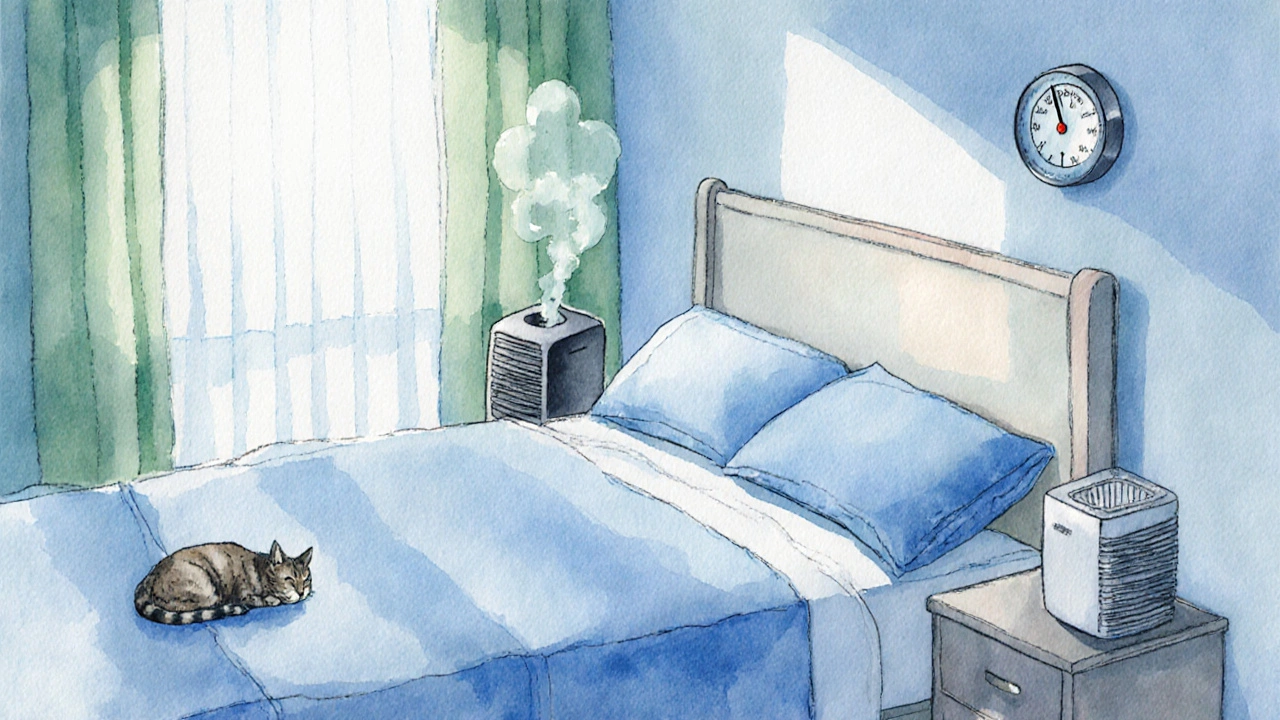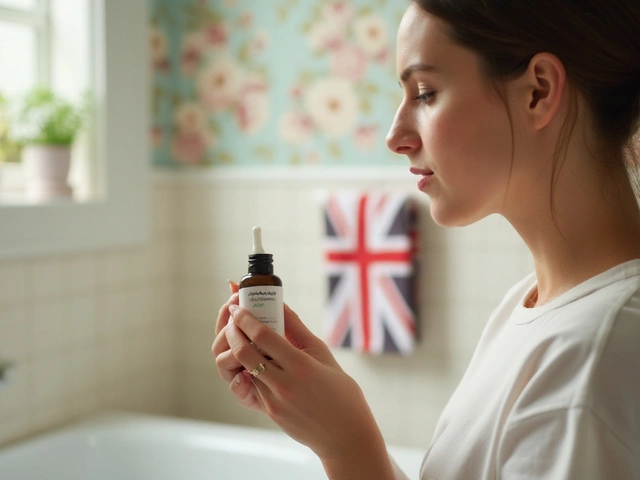Environmental Asthma Trigger Checker
Your Personalized Risk Assessment
When you hear the phrase environmental factors asthma, you probably picture smog or pollen clouds, but the reality is a lot richer. Bronchial asthma is a chronic inflammatory disease of the airways that causes wheezing, shortness of breath, and coughing. It doesn’t exist in a vacuum-every breath you take carries particles, gases, and humidity that can tip the balance between calm breathing and an attack. Understanding exactly which environmental pieces matter most helps you trim the risk, keep symptoms in check, and avoid costly emergency visits.
Quick Take
- Airborne pollutants (traffic, industry) worsen airway inflammation.
- Pollen and mold spikes coincide with seasonal flare‑ups.
- Indoor allergens like dust mites and pet dander are hidden triggers.
- Tobacco smoke-first‑hand or second‑hand-doubles the odds of severe attacks.
- Simple changes to ventilation, cleaning, and climate control can cut exposure by 30‑50%.
What Is Bronchial Asthma?
Bronchial asthma is a lifelong condition that affects roughly 339million people worldwide, according to the World Health Organization’s 2023 report. The disease is marked by reversible airway narrowing, increased mucus production, and heightened sensitivity to irritants. While genetics set the stage, environmental influences decide whether the condition stays mild or progresses to frequent, life‑threatening exacerbations. In other words, your DNA may hand you the script, but the stage-air quality, climate, home layout-writes the performance.
Key Environmental Triggers
Below are the most common culprits, each with a short scientific snapshot.
- Air pollution is a mix of particulate matter (PM2.5, PM10), nitrogen dioxide, and ozone that irritates the bronchial lining. Cities with PM2.5 above 35µg/m³ see 12‑15% more asthma‑related ER visits.
- Pollen is a seasonal plant‑derived allergen that triggers IgE‑mediated inflammation in susceptible individuals. Tree pollen peaks in spring, grass in early summer, and ragweed in autumn.
- Dust mites are microscopic arthropods that thrive in humid bedding and release allergenic proteins. Their presence is linked to persistent nighttime symptoms.
- Tobacco smoke contains over 7000 chemicals, many of which are known to cause airway hyper‑responsiveness. Even brief exposure can trigger a flare‑up.
- Indoor humidity influences both dust‑mite growth and mold spore release; levels above 60% are especially problematic.
- Temperature extremes can cause bronchoconstriction-cold air dries the airway lining while heat amplifies pollutant formation.
- Occupational chemicals such as isocyanates, silica, and cleaning solvents are common in manufacturing, painting, and healthcare settings, contributing to work‑related asthma.
How These Factors Worsen Symptoms
Each trigger follows a slightly different biological pathway, but the end result is the same: airway smooth‑muscle tightening and mucus plugging.
- Oxidative stress. Fine particles (PM2.5) generate free radicals that damage epithelial cells, prompting inflammatory cytokine release. \n
- Allergen‑specific IgE activation. Pollen, dust‑mite proteins, and pet dander bind to IgE on mast cells, causing histamine bursts.
- Neuro‑genic inflammation. Irritants like tobacco smoke stimulate sensory nerves, releasing neuropeptides that constrict airways.
- Thermal reflex. Cold air triggers a reflex bronchoconstriction via the vagus nerve, while hot, humid air can increase airway edema.
When two or more triggers act together-say, high pollen on a smoggy day-their effects compound, often leading to severe attacks that require oral steroids or hospitalisation.

Practical Steps to Cut Exposure
Below is a cheat‑sheet you can hang on the fridge. The actions are ranked by impact and ease of implementation.
- Check local air quality. Use apps that report PM2.5 and ozone levels; stay indoors when the AQI exceeds 100.
- Upgrade to HEPA filtration. Portable HEPA units remove >99% of particles down to 0.3µm and are especially effective in bedrooms.
- Control indoor humidity. Aim for 40‑50% using a dehumidifier in damp seasons; a hygrometer helps you monitor.
- Encase mattresses and pillows. Allergen‑proof covers block dust‑mite access and reduce nighttime coughing.
- Establish a pet‑free zone. Keep animals out of bedrooms and wash them weekly to lower dander.
- Quit smoking and avoid second‑hand smoke. Even a brief exposure can offset medication benefits.
- Schedule regular HVAC maintenance. Change filters every 3months and clean ducts to prevent mold growth.
Seasonal & Climate‑Change Considerations
Climate change isn’t just a future problem; it’s reshaping the asthma landscape today. Warmer winters extend pollen seasons, and higher CO₂ levels boost plant growth, leading to denser pollen clouds. Coastal cities see rising sea‑salt aerosol that can aggravate airway inflammation. The key is to adapt your routine as patterns shift.
- Spring‑early summer: Expect higher tree and grass pollen; wear sunglasses outdoors to reduce nasal exposure.
- Late summer‑autumn: Ragweed peaks; consider a short course of antihistamine tablets before outdoor activities.
- Winter: Indoor heating dries air; use a humidifier set to 45% and keep windows slightly ajar for ventilation.
Comparison of Indoor vs. Outdoor Triggers
| Trigger Type | Typical Source | Mitigation Tip |
|---|---|---|
| Air Pollution | Traffic fumes, industrial emissions | Check AQI, use indoor air purifiers on high‑pollution days |
| Pollen | Trees, grasses, weeds | Keep windows closed, shower after outdoor work |
| Dust Mites | Bedding, upholstered furniture | Use allergen‑impermeable covers, wash linens weekly at 60°C |
| Tobacco Smoke | Cigarettes, vape devices | Establish a strict smoke‑free home policy |
| Mold Spores | Bathrooms, basements with high humidity | Repair leaks promptly, use dehumidifier |
Checklist for an Asthma‑Friendly Home
- Air‑quality monitor installed in living room.
- HEPA filter active in bedroom and main sitting area.
- Humidity consistently between 40‑50%.
- Allergen‑proof mattress and pillow encasements.
- Pets kept out of bedroom, grooming routine thrice weekly.
- All windows equipped with fine‑mesh screens to block pollen.
- Weekly deep‑clean schedule: vacuum with HEPA, mop floors, dust surfaces.
- Zero‑smoke policy enforced for all residents and visitors.
Frequently Asked Questions
Can I outgrow bronchial asthma?
Around 30% of children see a reduction in symptoms by adulthood, but the underlying airway hyper‑responsiveness often remains. Managing environmental triggers remains crucial even if medication needs drop.
How quickly does air pollution affect my asthma?
Studies show measurable drops in lung function within minutes of a PM2.5 spike. For most people, symptoms peak 4‑6hours after exposure, making real‑time AQI monitoring vital.
Are air purifiers worth the cost?
A well‑placed HEPA unit can cut indoor particulate levels by up to 70%, translating to fewer night‑time attacks. Look for a Clean Air Delivery Rate (CADR) that matches your room size.
What role does diet play in environmental asthma triggers?
While diet doesn’t remove pollutants, antioxidants from fruits and omega‑3 fatty acids can blunt oxidative stress, reducing the severity of exposure‑related flare‑ups.
Should I invest in a smart thermostat for asthma control?
Yes. Smart thermostats maintain consistent temperature and humidity, preventing the swings that trigger bronchoconstriction. Pair it with a humidity sensor for optimal results.






Robert Jackson
October 1, 2025 at 18:25
According to epidemiological data, particulate matter under 2.5 microns (PM2.5) correlates directly with increased bronchial hyperresponsiveness, thereby exacerbating asthma symptoms. Moreover, ozone (O₃) concentrations above 70 ppb have been shown to precipitate acute attacks in susceptible individuals. The mechanistic pathway involves oxidative stress leading to airway inflammation and mucus overproduction. Urban environments typically exhibit elevated NO₂ levels due to vehicular emissions, which further aggravates bronchial constriction. Indoor humidity exceeding 70 % promotes mold spore proliferation, an established allergen for asthmatic patients. Conversely, relative humidity below 30 % can desiccate airway mucosa, increasing irritability. Smoking, including second‑hand exposure, introduces nicotine and carbon monoxide, both of which impair ciliary function and reduce pulmonary clearance. Seasonal pollen peaks, especially grass and ragweed, add an exogenous allergenic burden that synergizes with pollutants. Therefore, a comprehensive risk assessment must integrate outdoor air quality indices, indoor climate control, and personal exposure histories to formulate effective mitigation strategies.